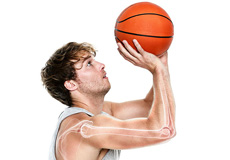
Throwing Injuries
An athlete uses an overhand throw to achieve greater speed and distance. Repeated throwing in sports such as baseball and basketball can place a lot of stress on the joints of the arm, and lead to weakening and ultimately, injury to the structures in the elbow. These overuse injuries may include:
- Inflammation or tears of the ulnar collateral ligaments (supportive tissue that supports the elbow joint).
- Inflammation of the flexor tendons (tissue connecting muscles of the forearm to the upper arm bone) at the inner side of the elbow.
- Wearing of cartilage (spongy protective tissue lining bones in a joint) over the olecranon (pointed elbow bone) and development of abnormal bony growths (bone spurs).
- Tiny cracks (stress fractures) of the olecranon.
- Irritation of the ulnar nerve.
Symptoms of Throwing Injuries
Throwing injuries can produce pain, numbness, tingling, and reduction in the throwing velocity.
Diagnosis of Throwing Injuries
When you present with symptoms of a throwing injury, your doctor will review your medical history, discuss your athletic activities and perform a thorough physical examination to examine the strength, range of motion, and stability of your elbow. Imaging tests (X-ray, MRI, and CT scans) may be ordered to confirm the diagnosis.
Treatment of Throwing Injuries
Your doctor may suggest a conservative approach to treatment such as rest, ice application, physical therapy, anti-inflammatory medications, and a modification of activity and throwing technique. If symptoms remain uncontrolled surgery may be performed to repair the injured tissues either through open surgery or a less invasive technique (arthroscopy) where a camera and instruments are inserted through a narrow tube. Surgery may be performed to reconstruct the ulnar collateral ligament and relocate the ulnar nerve to the front of the elbow. Four to six weeks of rehabilitation is recommended following surgery to prevent stiffness and improve strength and range of motion. Your doctor will discuss when it safe for you to return to your activities based on the injury and how well you recover.
